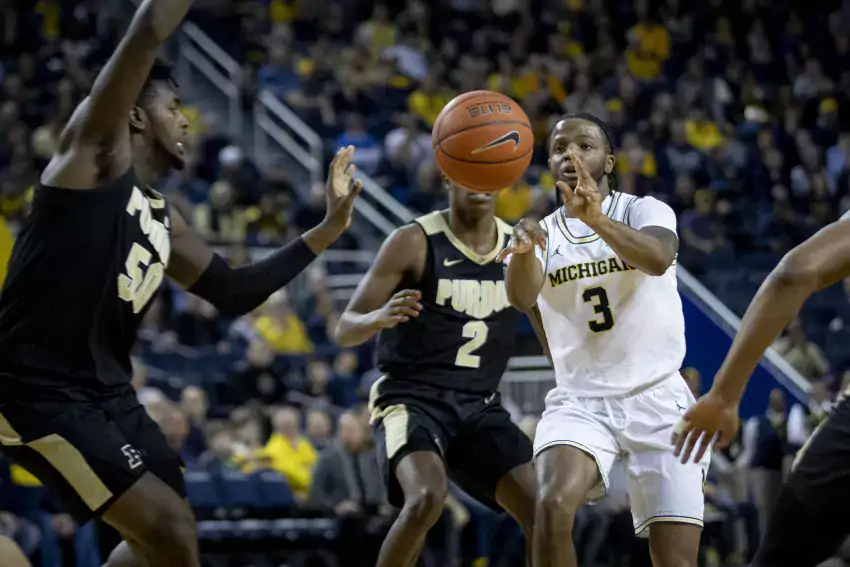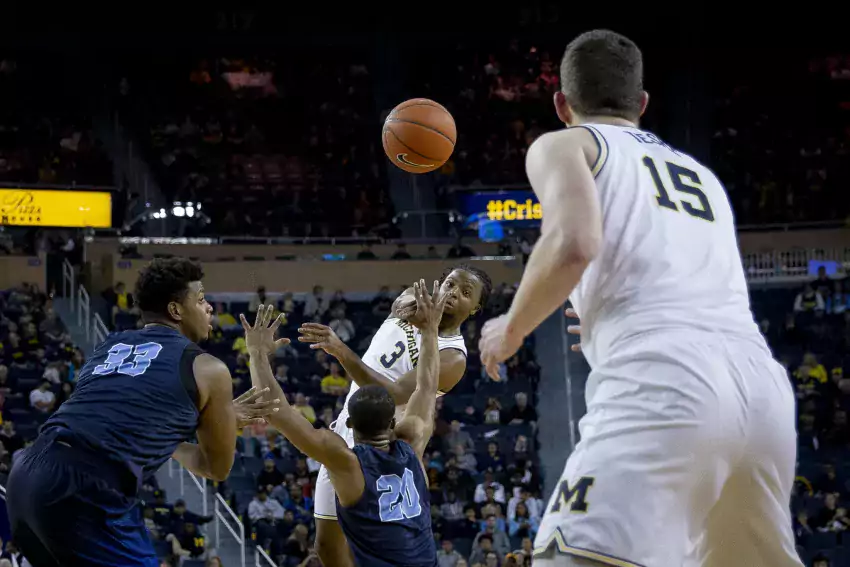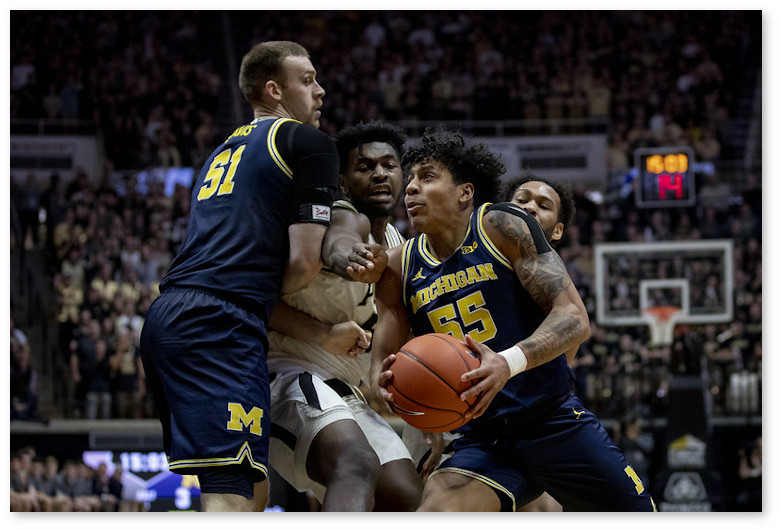zavier simpson as darius morris

Previously: Part One, Part Two. If you're looking for the Rutgers preview it's here.
You're definitely going to want to at least read part two of this series, which explains the stats I'm using below and details the 2009-14 seasons, before moving on to the rest of this post. Ideally, you'll read part one, as well.
Now that you're caught up, let's get to it.
2014-15: Bad Wheels
Team Stats: 27.7% pick-and-rolls + passes (#36 in country), 0.911 points per play (#62)
The Ballhandlers:
| P&R Plays (Own Offense) | PPP on Own Offense (%ile) | P&R Plays (Passes) | PPP on Passes (%ile) | Total P&R Plays | Overall P&R PPP. (%ile) | Keep % | |
|---|---|---|---|---|---|---|---|
| Spike Albrecht | 65 | 0.815 (70%) | 98 | 1.276 (92%) | 178 | 1.092 (93%) | 36.5% |
| Caris LeVert | 87 | 0.644 (35%) | 58 | 0.862 (34%) | 145 | 0.731 (28%) | 60.0% |
| Derrick Walton | 52 | 0.635 (33%) | 61 | 0.967 (54%) | 113 | 0.814 (47%) | 46.0% |
| Zak Irvin | 60 | 0.783 (63%) | 43 | 1.395 (96%) | 103 | 1.039 (90%) | 58.3% |
| MAAR | 39 | 0.872 (79%) | 19 | 1.737 (100%) | 58 | 1.155 (96%) | 67.2% |
The Screeners:
| Pop Plays (%) | Pop PPP (%ile) | Roll Plays | Roll PPP (%ile) | Slip Plays (%) | Slip PPP (%ile) | Overall Plays | Overall PPP (%ile) | |
|---|---|---|---|---|---|---|---|---|
| Max Bielfeldt | 12 (36.4%) | 1.167 (88%) | 19 (57.6%) | 1.000 (30%) | 2 (6.1%) | 2.000 (—) | 33 | 1.121 (76%) |
| Ricky Doyle | 1 (3.6%) | 2.000 (—) | 26 (92.9%) | 1.308 (74%) | 1 (3.6%) | 0.000 (—) | 28 | 1.286 (90%) |
| Zak Irvin | 9 (69.2%) | 1.222 (—) | — | — | 4 (30.8%) | 2.000 (—) | 13 | 1.462 (96%) |
| Mark Donnal | 1 (10%) | 3.000 (—) | 9 (90%) | 1.556 (—) | — | — | 10 | 1.700 (99%) |
I almost didn't include this season or the next because of Michigan's injury issues, then decided it was useful to see what happens when a team's two best perimeter players get hurt in the same season.
While neither Caris LeVert nor Derrick Walton were producing particularly well in the pick-and-roll before their respective foot injuries, we saw later that these injuries delayed breakouts into effective players—Walton, in particular, eventually became a great P&R ballhandler.
The players that remained were effective but one-dimensional. Spike Albrecht drove to pass. Zak Irvin and Muhammad-Ali Abdur-Rahkman hunted shots off of screens. Irvin, defying reputation, struck the best balance between shooting and passing, and he was a very effective passer. Only MAAR was above-average at generating his own offense off of screens, though.
Derrick Walton's foot injury stunted a developing rapport with Ricky Doyle
Michigan was also working with a limited group of finishers. Ricky Doyle was the best roll man but was a roll man only. Max Bielfedlt(!) ended up with the most plays among screeners even though he was a 30th-percentile finisher on the roll; he salvaged decent efficiency with some pick-and-pop jumpers. If Zak Irvin was setting a screen, it was to pop or slip for a jump shot.
This marks the first season since 2008-09 that Michigan's pick-and-roll usage went down; they also slipped 40 spots in the efficiency rankings. This team was going to drop off with the departures of Nik Stauskas, Glenn Robinson III, and Jordan Morgan, then injuries made matters worse. Even if LeVert and Walton weren't high-level P&R ballhandlers at this point, their spot-up shooting could've helped.
Even with all that, Michigan's pick-and-roll offense ranked in the 83rd percentile by points per play. They weren't elite; they were still good. They just couldn't build the offense around it to the extent they had the previous year.
2015-16: Bad Wheels 2
Team Stats: 30.5% pick-and-rolls + passes (#22 in country), 0.923 points per play (#80)
The Ballhandlers:
| P&R Plays (Own Offense) | PPP on Own Offense (%ile) | P&R Plays (Passes) | PPP on Passes (%ile) | Total P&R Plays | Overall P&R PPP. (%ile) | Keep % | |
|---|---|---|---|---|---|---|---|
| Derrick Walton | 128 | 0.711 (44%) | 120 | 1.000 (59%) | 248 | 0.851 (51%) | 51.6% |
| Zak Irvin | 149 | 0.826 (68%) | 98 | 1.306 (93%) | 247 | 1.016 (86%) | 60.3% |
| Caris LeVert | 57 | 0.877 (77%) | 62 | 0.855 (32%) | 119 | 0.866 (54%) | 47.9% |
| MAAR | 67 | 0.910 (82%) | 41 | 0.805 (24%) | 108 | 0.870 (55%) | 62.0% |
| Duncan Robinson | 19 | 0.632 (29%) | 17 | 0.647 (9%) | 36 | 0.639 (14%) | 52.8% |
The Screeners:
| Pop Plays (%) | Pop PPP (%ile) | Roll Plays | Roll PPP (%ile) | Slip Plays (%) | Slip PPP (%ile) | Overall Plays | Overall PPP (%ile) | |
|---|---|---|---|---|---|---|---|---|
| Mark Donnal | 12 (21.8%) | 0.500 (12%) | 40 (72.7%) | 1.250 (60%) | 3 (5.5%) | 0.667 (—) | 55 | 1.055 (60%) |
| Ricky Doyle | 1 (2.9%) | 2.000 (—) | 30 (88.2%) | 1.200 (54%) | 3 (8.8%) | 0.333 (—) | 34 | 1.147 (73%) |
| Moe Wagner | 3 (15.8%) | 1.667 (—) | 16 (84.2%) | 1.375 (77%) | — | — | 19 | 1.421 (95%) |
| DJ Wilson | 9 (64.3%) | 0.556 (—) | 4 (28.6%) | 1.500 (—) | 1 (7.1%) | 0.000 (—) | 14 | 0.786 (24%) |
| Zak Irvin | 9 (81.8%) | 1.000 (—) | — | — | 2 (18.2%) | 0.000 (—) | 11 | 0.818 (27%) |
An unfortunate repeat, as Walton's previous foot injury sapped his ability to finish at the rim and LeVert—who'd improved considerably as a scorer off the high screen—again lost most of the season to a bad wheel.
Beilein increased the volume past where it had been in 2013-14 and the team's PPP slightly increased, though they came out worse compared to the rest of the country. Irvin was easily the team's best P&R ballhandler, continuing to pass at a high level while making enough pull-up jumpers to be relatively effective as a scorer.
some of those jumpers were rather important
MAAR pulled off a tough feat, averaging more PPP using his own offense than when he passed; that's very much a good news/bad news situation.
The roll men remained limited. This was the year Ricky Doyle seemingly lost the ability to catch and finish, so Mark Donnal ended up as the primary screener. Neither graded out particularly well. The center who did: enigmatic freshman Moe Wagner, who scored well as a roll man and flashed the ability to pop out and hit jumpers.
[Hit THE JUMP for Michigan exploring that a bit more.]

Death By Variety: The Statistical View
I couldn't stay away from this topic, even after taking a look at Michigan's excellent pick-and-roll stats in last week's column. If you missed that, the main takeaway is that Michigan has the best combination of usage and efficiency on pick-and-rolls in the country:
Anyway: holy hell, Michigan's pick-and-roll offense. It's not just that they're the most efficient in the conference by a decent margin, they're also running it way more than the rest. The Wolverines are 12th in the country in efficiency and 11th in usage for pick-and-roll possessions. The only other major conference teams that have a comparable combination of usage and efficiency are Marquette and Seton Hall, and neither quite measure up.
I also touched on Zavier Simpson's remarkable acumen at running the pick-and-roll, something I'll get into more later in this column. Simpson isn't the only player making this work so well, however. After doing more digging into Synergy, it's fair to say Michigan has five legitimately good options as ballhandlers, and they each bring something a little different to the table.
Today I'm going to take a look at how Michigan is making that play work so well this season and how their lead ballhandlers stack up statistically against this year's competition. Tomorrow I'll put this year's pick-and-roll offense into a historical context.
 sneaky good [Campredon]
sneaky good [Campredon]
Here's a look at the five players on pick-and-roll plays with passes included. I've separated out when the ballhandler keeps the ball (or turns it over) from when they pass it and added a "keep percentage" stat to what Synergy already had to offer:
| P&R Possessions (Own Offense) | PPP on Own Offense (%ile) | P&R Poss. (Passes) | PPP on Passes (%ile) | Total P&R Poss. | Overall P&R PPP. (%ile) | Keep % | |
|---|---|---|---|---|---|---|---|
| Zavier Simpson | 172 | 0.709 (45%) | 310 | 1.139 (85%) | 482 | 0.985 (85%) | 35.7% |
| David DeJulius | 56 | 0.875 (78%) | 68 | 1.029 (71%) | 124 | 0.960 (81%) | 45.2% |
| Eli Brooks | 47 | 0.766 (58%) | 68 | 1.029 (71%) | 114 | 0.922 (74%) | 41.2% |
| Franz Wagner | 16 | 1.125 (97%) | 14 | 1.071 (78%) | 30 | 1.100 (95%) | 53.3% |
| Isaiah Livers | 18 | 0.889 (80%) | 9 | 1.000 (66%) | 27 | 0.926 (75%) | 66.7% |
Simpson, as you'd expect, mostly looks to pass and is the best on the team when he does; while he's not a huge threat to score, he does just enough to keep defenses honest and open up passing lanes.
While not as extreme as Simpson, Eli Brooks and David DeJulius both look to pass more than shoot, which is always good with point guards—passing out of the pick-and-roll is more efficient on average than keeping it because the latter usually implies sound defense. DeJulius has also been quite effective when he looks to score; he's on track to be the lead guard next season.
Although the sample size is merely 30 possessions, Franz Wagner has flashed an elite ability to score off the screen—he's over 1.1 points per possession when no other Wolverine cracks 0.9. He's passing about half the time with efficiency that approaches Simpson's. What's most impressive about the scoring is it's mostly come on drives; if Wagner adds a pull-up three-pointer he'll be absolutely lethal. Think a longer Nik Stauskas. Try not to drool.
While not in Wagner's territory, Isaiah Livers has been a solid option as a pick-and-roll scorer. He doesn't look to pass as much but he's on this team to get buckets.
[Hit THE JUMP for moving picture pages and how M's ballhandlers stack up against the Big Ten.]

1/10/2019 – Michigan 79, Illinois 69 – 16-0, 5-0 Big Ten
Rotate. Michigan won this game on the strength of Jon Teske and Zavier Simpson, if you had to pick two people. Against Indiana it was Poole and Matthews. Penn State: Simpson and Matthews. Northwestern: Brazdeikis and Poole. Purdue: Brazdeikis and Poole.
2